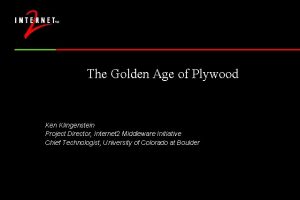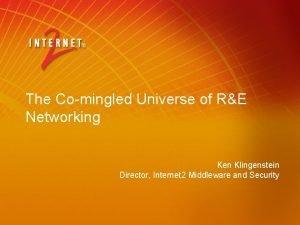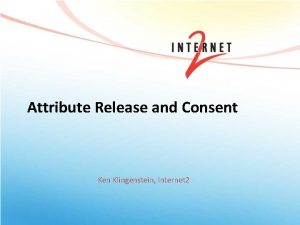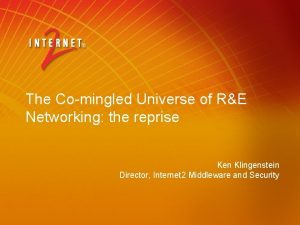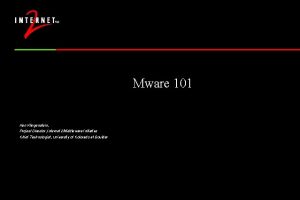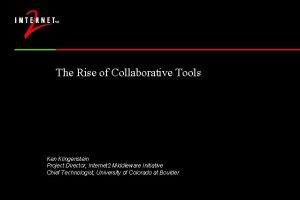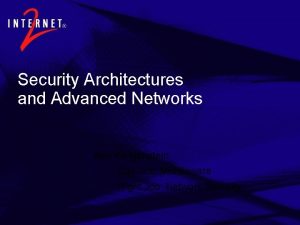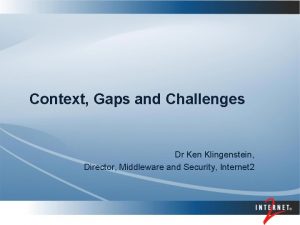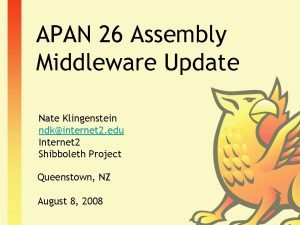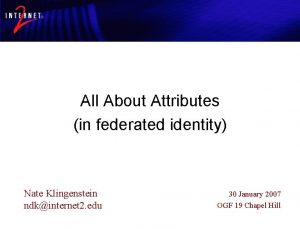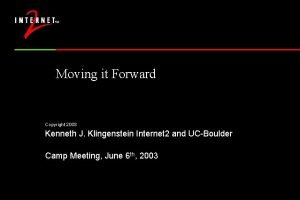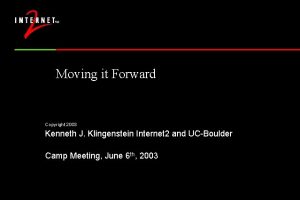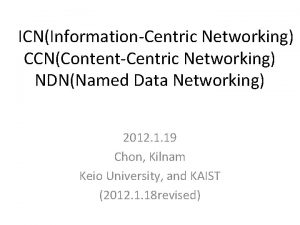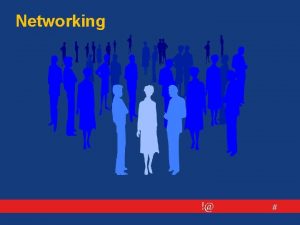The Comingled Universe of RE Networking Ken Klingenstein

















- Slides: 17

The Co-mingled Universe of R&E Networking Ken Klingenstein Director, Internet 2 Middleware and Security

Topics • • • A brief history from a good seat… Going forward “opportunities” Characteristics of R&E networking Relating to corporate requirements What does comingled mean? • To the current commodity • To the future clean slate… 2

A Brief History … • Getting onto Arpanet… • The mid ’ 80’s • JVNC, NSFnet, ESNet, BITnet, CSNet • On-campus, the shift from TN 3270 to campus nets • The mid ’ 90’s • v. BNS, Abilene, etc • The emergence of the border router • On-campus, from multiprotocols to TCP/IP 3

And now… • A major R&E institution has several external connections, with distinct characteristics (performance, AUP’s, etc. ) • Complex campus networks, with highperformance meshes, lower-speed extensions, clusters of advanced nets, etc. • Distributed management of networks and desktops • Lots of special cases, like Medical Schools, Engineering Colleges, Dormitories 4

And now… • Security challenges • • The demise of the fictitious perimeter Roaming devices Wireless Slow to deploy DNSSec and problematic IPSec • The prospect of new types of external non-IP connections • Complex, undiagnosable deployments • Policy drivers for technology 5

Going Forward “Opportunities”… • • The prospect of on-demand personal “lambdas” Infocard Federated identity and trust Uneven economics 6

Characteristics of R&E Networking • Enterprise centric • Networking is part of an infrastructure provided to members. Operated often as a common good • Often run to a building or POP in a sub-unit; often some wall-plate services as well • Desktop autonomy • Heterogeneity of platforms • Loose desktop management • Leading edge • Early developers/adopters of new technologies • Regulatory complexity • HIPAA, FERPA, AUP, DMCA 7

More characteristics • Demanding applications • Bandwidth, latency, jitter, transparency • Strong inter-institutional requirements • Multiple external links • AUP’s • Performance distinctions • Funding that favors one-time versus continuing costs 8

Relating to corporate needs • From the Jericho forum: • Can no longer assume that an organization owns, controls and is accountable for the ICT infrastructure it employs • Should not assume that all individuals sit within organizations and are managed by a single Id. M • Vision statement: • Cross-organizational security processes and services • Open standards • Assurance processes that when used in one organization can be trusted by others 9

Network Applications Consortium • NAC - a group of 25 -30 major companies (Boeing, Bechtel, Glaxo. Smith. Kline, PG&E, etc. ) with intermingled research and operational environments • Welcome to the Network Applications Consortium "where membership radically improves the delivery of agile IT infrastructure in support of business objectives" • Original focus was on middleware, where Internet 2 and NAC members have had meaningful if sporadic interactions • Added focus over the last year on network security 10 • http: //www. netapps. org/

NAC Enterprise Security Architecture Key Concepts: • Security by design • Usability and manageability • Defense in depth • Simplicity • Enforced policy Key leveraging technologies: • Identity Management • Directory Services • Border Protection • Reusable tools • Desktop management 11

Comingled with the commodity • The commodity Internet is a part of the R&E network environment • With its security issues • With its packet disruption appliances • With its legacy requirements • True to being the original crucible, new deployments in commodity often begin in R&E • Multicast, IPv 6, DNSSec 12

Co-mingled with the future • It is likely that any advanced network initiatives will have presence on campuses and require integration. • Forces may drive management of long distance networking to the end points • Layers of invention that new networking approaches could leverage are being developed in the R&E community • Trust fabrics • Manageability discussions 13

Distinctions? • This workshop is more on architectures than protocols • We have steep requirements around policy • We are driven by researcher needs as much as by economics, capabilities, security, policy, etc. 14

Questions -1 • Role of enterprise vs role of VO vs role of individual • In authn/z • In provisioning networking • In resource discovery, etc… • What role will the enterprise have in personal lambdas? • What parts of the infrastructure will the enterprise own? Manage? 15

Questions -2 • What parts of manageability matter? Costs, downtime, security, privacy… • Does the control plane/data plane distinction continue to matter? Do we need more planes or less? (remember dynamic networking…) • How will diagnostics happen in the face of complexity, higher levels of performance, scale, etc? • How will resource discovery be addressed at so many layers? 16

Questions - 3 • How important is e 2 e transparency? How important is innovation in the face of security? • What will drive change? • How will devices and appliances on the net change the problem? • Will outsourcing, offshoring etc affect R&E nets? 17
 Ken klingenstein
Ken klingenstein Ken klingenstein
Ken klingenstein Ken klingenstein
Ken klingenstein Software defined networking vs traditional
Software defined networking vs traditional Greiner-klingenstein diagramm
Greiner-klingenstein diagramm Một số thể thơ truyền thống
Một số thể thơ truyền thống Trời xanh đây là của chúng ta thể thơ
Trời xanh đây là của chúng ta thể thơ Thế nào là hệ số cao nhất
Thế nào là hệ số cao nhất Ng-html
Ng-html Sơ đồ cơ thể người
Sơ đồ cơ thể người Số nguyên tố là
Số nguyên tố là đặc điểm cơ thể của người tối cổ
đặc điểm cơ thể của người tối cổ Tia chieu sa te
Tia chieu sa te Các châu lục và đại dương trên thế giới
Các châu lục và đại dương trên thế giới Glasgow thang điểm
Glasgow thang điểm ưu thế lai là gì
ưu thế lai là gì Tư thế ngồi viết
Tư thế ngồi viết Cái miệng nó xinh thế chỉ nói điều hay thôi
Cái miệng nó xinh thế chỉ nói điều hay thôi
